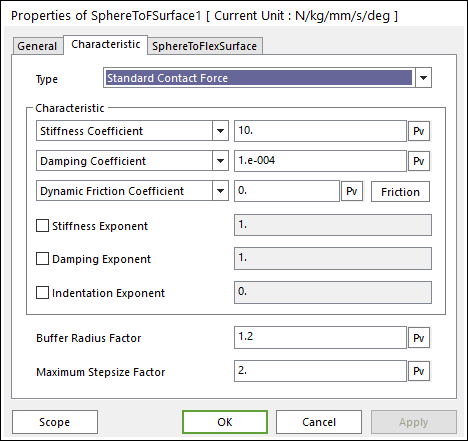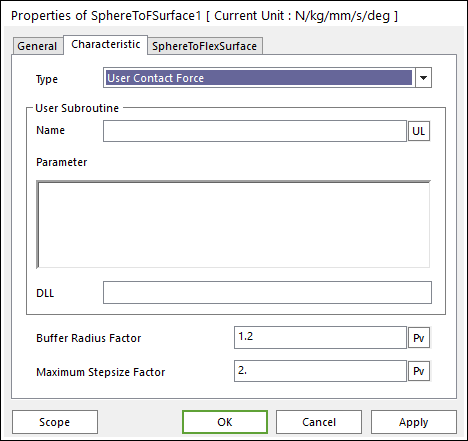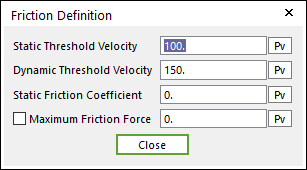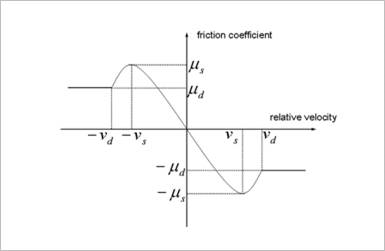9.9.1.2. Characteristic page

Figure 9.129 Characteristics tab of the Properties of SphereToFSurface dialog box [Standard Contact Force]

Figure 9.130 Characteristics tab of the Properties of SphereToFSurface dialog box [User Contact Force]
Type: Allows you to select Standard Contact Force or User Contact Force. In the case of User Contact Force, the contact force is defined by the user’s written contact subroutine (Refer to CONTACT_FORCE).
Characteristic: Defines the contact properties such as the stiffness coefficient, damping coefficient, and friction coefficients. Also, these coefficients are given as user-defined spline curves.
Stiffness Coefficient: Specifies a stiffness coefficient for the contact normal force.
Damping Coefficient: Specifies a viscous damping coefficient for the contact normal force.
Exponent
Stiffness and Damping Exponent: Generates a non-linear contact normal force.
Indentation Exponent: Yields an indentation damping effect.
When the penetration is very small, the contact force is negative due to a negative damping force, which is not realistic.
This situation is overcome by using the indentation exponent greater than one.
The contact normal force is calculated by
\({{f}_{n}}=k{{\delta }^{m1}}+c\frac{{\dot{\delta }}}{\left| {\dot{\delta }} \right|}{{\left| {\dot{\delta }} \right|}^{m2}}{{\delta }^{m3}}\)
- Where,
- \(k\) and \(c\) are the stiffness and damping coefficients which are determined by an experimental method, respectively.\(m1\), \(m2\), and \(m3\) are the stiffness, damping and indentation exponents.\(\delta\) and \(\dot{\delta }\) are a penetration and time differentiation of the penetration, respectively.
Dynamic Friction Coefficient: Specifies a dynamic friction coefficient for the contact friction force. It gives three options.
Dynamic Friction Coefficient: The constant friction coefficient is applied.
Friction Force Spline: Shows the relative velocity to the friction force.
Friction Coefficient Spline: Shows the relative velocity to the friction coefficient.
User Subroutine
Name: Is the name of user specified subroutine.
Parameter: Shows the parameters used in the user specified subroutine.
DLL: Shows the name of which DLL contains the contact user subroutine.
Buffer Radius Factor: The numerical integrator reduces the step size by the maximum step size factor if the action body come closer than Buffer radius factor \(\times\) Action body radius.
Maximum Step Size Factor: The maximum step size is reduced by a factor of maximum step size factor.
9.9.1.2.1. Friction
Specifies some friction coefficients for the contact friction force as shown in Figure 9.131.

Figure 9.131 Friction Definition dialog box
Static Threshold Velocity [ \(Length/Second\) ]: If the relative velocity between a contact pair is less than this value, the friction coefficient is defined as following.
\(\mu =\text{step5}(\nu ,\,\,-{{\nu }_{s}},\,\,{{\mu }_{s}},\,\,{{\nu }_{s}},\,\,-{{\mu }_{s}}\,)\)
Dynamic Threshold Velocity [ \(Length/Second\) ]: If the relative velocity between a contact pair is greater than:
This value, the friction coefficient is same as the specified dynamic friction coefficient.
Static Threshold Velocity and less than this value, the friction coefficient is defined as following.
\(\mu =\text{step5}\,(\nu ,\,\,{{\nu }_{s}},\,\,-{{\mu }_{s}},\,\,{{\nu }_{d}},\,\,-{{\mu }_{d}}\,)\)
Static Friction Coefficient: Specifies a static friction coefficient.
Maximum Friction Force [ \(Force\) ]: If this is checked, the contact friction force is limited to this value.

Figure 9.132 Relationship between relative velocity and friction coefficient
The friction force of contact elements is determined by the following equations.
\(\begin{aligned} & {{f}_{f}}=-\,\text{sign}\,(\nu)\,\,\left| \mu (\nu) \right|\,\,\left| {{f}_{n}} \right| \\ & {{f}_{f}}=\,\text{sign}\,({{f}_{f}})\,\times \min \left( \left| {{f}_{f}} \right|,{{f}_{\max }} \right) \\ \end{aligned}\)
Where,
\({{f}_{n}}\), \({{f}_{f}}\) and \({{f}_{\max }}\) are the contact normal force, the friction coefficient, and the maximum friction force, respectively.
The friction coefficient of \({{f}_{f}}\) is determined by a relative and tangential velocity on the contact point as shown in Figure 9.132.